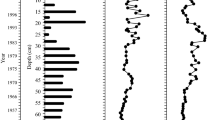Abstract
Massive Cladophora growth was reported half a century ago around Birds Island in Qinghai Lake, and in 2015, Cladophora populations have rebloomed and have formed green “meadows,” with areas up to thousands of hectares. The present study investigated the distribution and biomass of Cladophora in Qinghai Lake and found that two key factors contribute to Cladophora blooming. First, recent climate change, especially increased precipitation, has induced the expansion of the lake’s area, and the submerged grassland around Birds Island has provided a plethora of grass stems on which Cladophora can attach and twine. In addition, the submerged grasslands are covered with less than 1 m of water, which allows enough sunlight to support the growth of Cladophora on available substrates. Second, the submerged grassland may function as a key source of nutrients, especially phosphate. A large number of migratory birds live in these area for very long times, which lead to higher phosphorus content due to the accumulated birds dropping. Thus, the high phosphate level further exacerbates the massive growth. Future studies should investigate the functions of Cladophora in the nutrient cycling of submerged areas, and the improvement of methods for removing Cladophora biomass.











Similar content being viewed by others
References
Ao HY, Wu CX, Xiong X, Jing LD, Huang XL, Zhang K, Liu JT (2014) Water and sediment quality in Qinghai Lake, China: a revisit after half a century. Environ Monit Assess 186:2121–2133
Bootsma HA, Rowe MD, Brooks CN, Vanderploeg HA (2015) Commentary: the need for model development related to Cladophora and nutrient management in Lake Michigan. J Great Lakes Res 41:7–15
Higgins SN, Pennuto CM, Howell E, Lewis TW, Makarewicz JC (2012) Urban influences on Cladophora blooms in Lake Ontario. J Great Lakes Res 38:116–123
Kang S, Xu Y, You Q, Flügel WA, Pepin N, Yao T (2010) Review of climate and cryospheric change in the Tibetan Plateau. Environ Res Lett 5(1):015101
Lambert RS, Auer MT, Effler SW, Greene MR, Downer BE, Kuczynski A (2015) Onondaga to Ontario: management of bioavailable phosphorus in municipal wastewaters for control of Cladophora. J Great Lakes Res 41(4):1106–1113
Li X, Xu H, Sun Y, Zhang D, Yang Z (2007) Lake-level change and water balance analysis at Lake Qinghai, west China during recent decades. Water Resour Manag 21(9):1505–1516
Ma R, Duan H, Hu C, Feng X, Li A, Ju W, Jiang J, Yang G (2010) A half-century of changes in China's lakes: global warming or human influence? Geophys Res Lett 37(24):L24106
Qiao B, Zhu L, Yang R (2019) Temporal-spatial differences in lake water storage changes and their links to climate change throughout the Tibetan Plateau. Remote Sens Environ 222:232–243
Ren Z, Niu D, Ma P, Wang Y, Fu H, Elser JJ (2019) Cascading influences of grassland degradation on nutrient limitation in a high mountain lake and its inflow streams. Ecology:e02755
Wu Z, Mo Z, Gu Y (1979) A comprehensive survey report on the Qinghai Lake. Science Press, Beijing, pp 44–66
Zhang G, Yao T, Xie H, Kang S, Lei Y (2013) Increased mass over the Tibetan Plateau: from lakes or glaciers? Geophys Res Lett 40(10):2125–2130
Zhu H, Zhao ZJ, Liu XD, Song HY, Hu ZY, Liu GX (2018) Molecular phylogeny and morphological diversity of inland Cladophora (Cladophorales, Ulvophyceae) from China. Phycologia 57(2):191–208
Funding
This work was supported by the Featured Institute Service Project program of the Institute of Hydrobiology, Chinese Academy of Sciences (Grant No. Y85Z061601), and by The Second Tibetan Plateau Scientific Expedition and Research program (Grant No. 2019QZKK0304).
Author information
Authors and Affiliations
Corresponding author
Additional information
Responsible Editor: Vitor Manuel Oliveira Vasconcelos
Publisher’s note
Springer Nature remains neutral with regard to jurisdictional claims in published maps and institutional affiliations.
Rights and permissions
About this article
Cite this article
Zhu, H., Xiong, X., Ao, H. et al. Cladophora reblooming after half a century: effect of climate change-induced increases in the water level of the largest lake in Tibetan Plateau. Environ Sci Pollut Res 27, 42175–42181 (2020). https://doi.org/10.1007/s11356-020-10386-y
Received:
Accepted:
Published:
Issue Date:
DOI: https://doi.org/10.1007/s11356-020-10386-y




